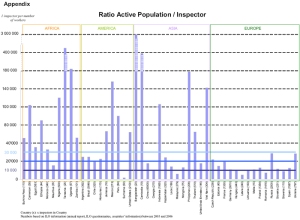The International Labour Organization ( ILO ) publishes a recommendation regarding the ratio of inspectors to population. In a recent report, it made this comment:
Article 10 of Convention No. 81 calls for a “sufficient number” of inspectors to do the work required. As each country assigns different priorities of enforcement to its inspectors, there is no official definition for a “sufficient” number of inspectors. Amongst the factors that need to be taken into account are the number and size of establishments and the total size of the workforce. No single measure is sufficient but in many countries the available data sources are weak. The number of inspectors per worker is currently the only internationally comparable indicator available. In its policy and technical advisory services, the ILO has taken as reasonable benchmarks that the number of labour inspectors in relation to workers should approach: 1/10,000 in industrial market economies; 1/15,000 in industrializing economies; 1/20,000 in transition economies; and 1/40,000 in less developed countries
Strategies and practice for labour inspection GB.297/ESP/3 297th Session Geneva, November 2006
The ILO published data posted below shows that many jurisdictions fail to come close to these ILO recommended levels:
[caption id="attachment_142" align="alignnone" width="300" caption="ILO Ratio of Active Population to Inspector"]
 [/caption]
[/caption]The ratio of 1 inspector for every 10,000 active population (employment, or employed labour force) for industrialized jurisdictions like Canada, the US and Australia is just a guideline. Australia and New Zealand publish ratios for their respective jurisdictions. Data in Canada and the US are harder to come by. Where data exist, it is often difficult to verify what is included and excluded from each component of the ratio.
For WorkSafeBC, I use the 2009 count of field inspectors and investigation officers to ‘employment’ for December 2009 as published by BC Stats. This is imperfect for many reasons. This would include among workers those working in mining and communications (outside WorkSafeBC’s occupational safety and health mandate but within the workers' compensation mandate); the calculations also exclude Mines inspectors and Labour Standards inspectors (inspectors that might be included in some calculations). I suspect every jurisdiction would face similar challenges in preparing their ratios.
Keeping these caveats mind, I have gathered some of Inspector-to-Worker Ratios below:
California 1 : 69,613 (a)
Washington State 1 : 32,141 (b)
Oregon 1 : 22,239 (c)
Queensland, Australia 1 : 12,000 (d)
New Zealand 1 : 12,000 (d)
New South Wales, Australia 1 : 10,000 (d)
Victoria, Australia 1 : 9,000 (d)
British Columbia 1 : 9,100 (e)
Based on the range of jurisdictions in this short list, BC and the Australian jurisdictions have ratios nearest the ILO recommendation.
I have noted the sources for each of the ratios posted below. If you have a better or more recent source, or another similar ratio from an additional jurisdiction, please feel free to post a comment.
(a) California Department of Industrial Relations, Division of Occupational Safety and Health (DOSH), September 2, 2010
(b) Washington Department of Labour and Industries, September 2, 2010
(c) Oregon Department of Consumer and Business Services, Occupational Safety and Health Agency (OR-OSHA)
(d) Calculated from data in Indicator 14 for year 2007/8 Comparative Performance Monitoring Report, 11th Edition, Dec 2009
(e) Calculated from 2009 data on actual number of officers (249) and covered employed labour force as reported by BC Stats December 2009 (2.266 million)

No comments:
Post a Comment